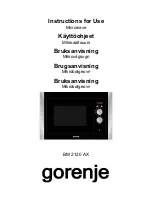
R380L(W)
9 – 2
3. Detector Circuit of Absolute Humidity Sensor Circuit
This detector circuit is used to detect the output voltage of the absolute humidity circuit to allow the LSI to control sensor cooking of the unit. When the
unit is set in the sensor cooking mode, 16 seconds clearing cycle occurs than the detector circuit starts to function and the LSI observes the initial
voltage available at its AN6 terminal.With this voltage given, the switches SW1 to SW5 in the LSI are turned on in such a way as to change the resis-
tance values in parallel with R98 ~ R102. Changing the resistance values results in that there is the same potential at both F-3 terminal of the abso-
lute humidity sensor and AN5 terminal of the LSI. The voltage of AN6 terminal will indicate about -2.5V. This initial balancing is set up about 16
seconds after the unit is put in the Sensor Cooking mode. As the sensor cooking proceeds, the food is heated to generate moisture by which the
resistance balance of the bridge circuit is deviated to increase the voltage available at AN6 terminal of the LSI.
Then the LSI observes that voltage at AN6 terminal and compares it with its initial value, and when the comparison rate reaches the preset value
(fixed for each menu to be cooked), the LSI causes the unit to stop sensor cooking; thereafter, the unit goes in the next operationautomatically.When
the LSI starts to detect the initial voltage at AN6 terminal 16 seconds after the unit has been put in the Sensor Cooking mode, if it is not possible to
balance the bridge circuit due to disconnection of the absolute humidity sensor, ERROR will appear on the display and the cooking is stopped.
1)Absolute humidity sensor circuit
[3] SERVICING FOR TOUCH CONTROL PANEL
1. Precautions for Handling Electronic Components
This unit uses CMOS LSI in the integral part of the circuits.When handling these parts, the following precautions should be strictly followed. CMOS
LSI have extremely high impedance at its input and output terminals. For this reason, it is easily influenced by the surrounding high voltage power
source, static electricity charge in clothes, etc. and sometimes it is not fully protected by the built-in protection circuit.
In order to protect CMOS LSI.
1) When storing and transporting, thoroughly wrap them in aluminium foil. Also wrap all PW boards containing them in aluminium foil.
2) When soldering, ground the technician as shown in the figure and use grounded soldering iron and work table.
2. Servicing of Touch Control Panel
We describe the procedures to permit servicing of the touch control panel of the microwave oven and the precautions you must take when doing so.
To perform the servicing, power to the touch control panel is available either from the power line of the oven itself or from an external power source.
1. Servicing the touch control panel with power supply of the oven:
C
S
R 3
R 1
R 2
+
-
Operational
amplifier
Output
voltage
S : T hermis tor
open ves s el
C : T hermis tor
clos ed ves s el
2
Abs olute humidity (g/m )
O
u
tp
u
tv
o
lt
a
ge
Abs olute humidity vs ,
output voltage characteris tic
SW1
SW2
SW3
SW4
SW5
P40
P41
P42
P43
P44
LSI
(IC1)
AN5
AN6
620k
300k
150k
75k
37.4k
6
3
2
1
64
4
5
15k
15k
4.7k
1 2 3 4
8 7 6 5
0.01uF
0.015uF
0.01
u
F
VA : -15V
VA : -15V
R90
C90
C91
C93
C9
2
S
F-2
1.8k
IC2
F-1
F-3
C
3.57k
3.32k
VC : -5V
0.1 uF
C. Thermistor in
closed vessel
S. Thermistor in
open vessel
R98
R99
R96
R91
360k
R93
R92
R94
R95
D90
R100
R101
R102
R97
approx. 1M ohm
















































